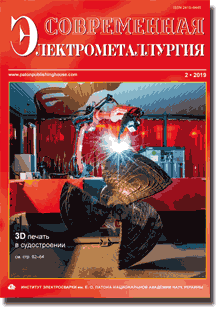| 2019 №02 (06) |
DOI of Article 10.15407/sem2019.02.07 |
2019 №02 (08) |

Electrometallurgy Today (Sovremennaya Elektrometallurgiya), 2019, #2, 43-49 pages
Journal Современная электрометаллургия
Publisher International Association «Welding»
ISSN 2415-8445 (print)
Issue № 2, 2019 (June)
Pages 43-49
Mechanical properties of dispersed and laminar composite materials on copper and molybdenum base
N.I. Grechanyuk1, V.G. Grechanyuk2
1I.M. Frantsevich Institute for Problems of Materials Science of the NAS of Ukraine. 3 Krzhizhanovsky str., 03142, Kyiv, Ukraine, Е-mail: dir@ipms.kiev.ua
2Kiev National University of Construction and Architecture. 31 Vozdukhoflotsky Ave., 03037, Kyiv. E-mail: knuba@knuba.edu.ua
The effect of technological factors (material, level and shape of surface roughness, on which the condensation is realized; material and thickness of a separating layer; substrate temperature; depths and dynamics of vacuum change; chemical composition and rate of evaporation of initial materials; angle of incidence of vapor flow on condensation surface) on change in mechanical properties of composite materials Cu–Mo with molybdenum concentration from 0 up to 46.5 wt.%., condensed from the vapor phase, was analyzed. Ref. 9, Tabl. 2, Fig. 3.
Key words: electron beam evaporation; pseudo alloys; copper; molybdenum; mechanical properties
Received: 11.04.19
Published: 13.06.19
References
1. Grechanyuk, N.I., Grechanyuk, V.G., Khomenko E.V. et al. (2016) Modern composite materials for switching and welding equipment. Information 2. Application of high-rate vacuum evaporation methods for manufacturing electric contacts and electrodes. The Paton Welding J., 2, 34-39. https://doi.org/10.15407/tpwj2016.02.062. Grechanyuk, N.I., Grechanyuk, V.G. (2018) Dispersed and laminar volumetric nanocrystal materials on base of copper and molybdenum. Structure, properties, technology, application. Information 1. Structure and phase composition. Sovrem. Elektrometall., 1, 42-53 [in Russian]. https://doi.org/10.15407/sem2018.01.06
3. Grechanyuk, N.I., Osokin, V.A., Grechanyuk, I.N. et al. (2006) Composite materials on base of copper and molybdenum, condensed from vapor phase, for electric contacts. Structure, properties, technology. Pt 2. Fundamentals of electron beam technology for producing materials for electric contacts. Advances in Electrometallurgy, 2, 8–17.
4. Grechanyuk, V.G. (2013) Physical-mechanical principles of formation of composite materials on base of copper, condensed from vapor phase: Syn. of Thesis for Dr. of Chem. Sci. Degree, Kyiv, IPM [in Ukrainian].
5. Grechanyuk, I.M. (2007) Structure, properties and electron beam technology of produced Cu–Mo–Zr–Y composite materials for electric contacts: Syn. of Thesis for Cand. of Techn. Sci. Degree, Kyiv, IPM [in Ukrainian].
6. Demchishin, A.V. (1981) Structure and properties of thick vacuum condensates of metallic and nonmetallic materials and scientific principles of their production: Syn. of Thesis for Dr. of Techn. Sci. Degree, Kiev, PWI [in Russian].
7. Rabinovich, V.A., Khavin, Z.Ya. (1978) Concise chemical reference book. Khimiya, Leningradskoe Otdelenie [in Russian].
8. Minakova, R.V., Grechanyuk, M.I., Zatovsky, V.G. et al. (2010) About some peculiarities of structure and properties of thick vapor phase condensates based on copper and iron. Elektronnaya Mikroskopiya i Prochnost Materialov, 17, 37–44 [in Ukrainian],
9. Osokin, V.O. (1990) Structure, properties and electron beam technology of producing composite materials on base of copper: Syn. of Thesis for Cand. of Techn. Sci. Degree, Kiev, PWI [in Russian].
